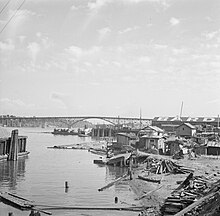By Camille Thrall

There were hundreds of Hoovervilles across the country during the 1930s. During the Great Depression, hundreds of thousands of people lived in these slums. A "Hooverville" was a Shanty Town (Slums) built during the Great Depression by the hopeless, jobless, and homeless in the United States. They were named after President Herbert Hoover, who was President of the United States of America during the onset of the Depression and was widely blamed for it. The term was coined by Charles Michelson, publicity chief of the Democratic National Committee.
Most large cities built municipal lodging houses for the homeless, but the Depression raised demand for cheap housing. The unemployed and clustered in shanty towns close to free soup kitchens. President Roosevelt's New Deal created special relief programs for the homeless under the Federal Transient Service.

Some of the men who were forced to live in these homeless towns were able to build their houses out of stone. Most people, however, resorted to building their residences out of wood from crates, cardboard, scraps of metal, or whatever materials were available to them. They usually had a small stove, bedding and a couple of simple cooking implements. Men, women and children alike lived in Hoovervilles. Most of these unemployed residents of the Hoovervilles used public charities or begged for food from those who had housing during this era.
Democrats coined many names based on Herbert Hoover: such as "Hoover blanket", old newspaper used as a blanket, "Hoover flag", an empty pocket turned inside out to show that there was no money in it, "Hoover leather" was cardboard used to line a shoe when the sole wore through, and a "Hoover wagon" was an automobile with horses hitched to it because the owner could not afford fuel.
After 1940 the economy recovered, unemployment fell, and shanty eradication programs destroyed all the Hoovervilles, but their name still lives on as spite for President Hoover, whom many people blamed for the great depression because he did not do enough.
Poverty in the United States: A – K
http://www.nytimes.com/1993/08/29/realestate/streetscapes-central-park-s-hooverville-life-along-depression-street.html
Camille, I thought your post was very informative on Hoovervilles and details about life in those shanty towns. I found it interesting that the people within those homeless towns blamed President Hoover for the Depression, and the Democratic Party itself named many items after Hoover perhaps to reduce public support of his tenure in office. One of the largest Hoovervilles at that time was actually in Central Park in New York, and the people who lived there were forced to build their own homes out of scraps of lumber, cardboard, glass, and other materials from dumpsters. I wonder how living in these shanty towns would have an effect on the people's morale; obviously, they held grudges against the government for causing them to lose basically everything they had.
ReplyDeletehttp://www.u-s-history.com/pages/h1642.html
Great post Camille! I agree with every Julia said, I found it super interesting that the homeless people pegged all the blame on President Hoover. Interesting I think to have people blaming all their misfortune on the president in comparison to social darwinism flourishing at the same time in which if you were poor, it was because of your doing. Answering Julia's question about morale, I found that the Hoovervilles has a shocking sense of community and the there was not a major problem with morale and many of the hoover towns even planned their own festivities, however one thing that was rampant in Hoovervilles was alcoholism. So now I am left curious about the details of how alcoholism effected the towns.
ReplyDeletehttp://depts.washington.edu/depress/hooverville_seattle_tarpaper_carthage.shtml
I found the description of Hoovervilles very interesting and how the people felt about the president in these towns. You can see the effects of social darwinism taking place during this time period, as people took it personally if they were poor, and blamed themselves. One Hooverville you could check out is:http://www.stltoday.com/news/local/a-look-back-settWhy%20does%20Jackson%20believe%20that%20even%20though%20military%20authorities%20have%20the%20power%20to%20violate%20constit that was along the Mississippi river.
ReplyDelete